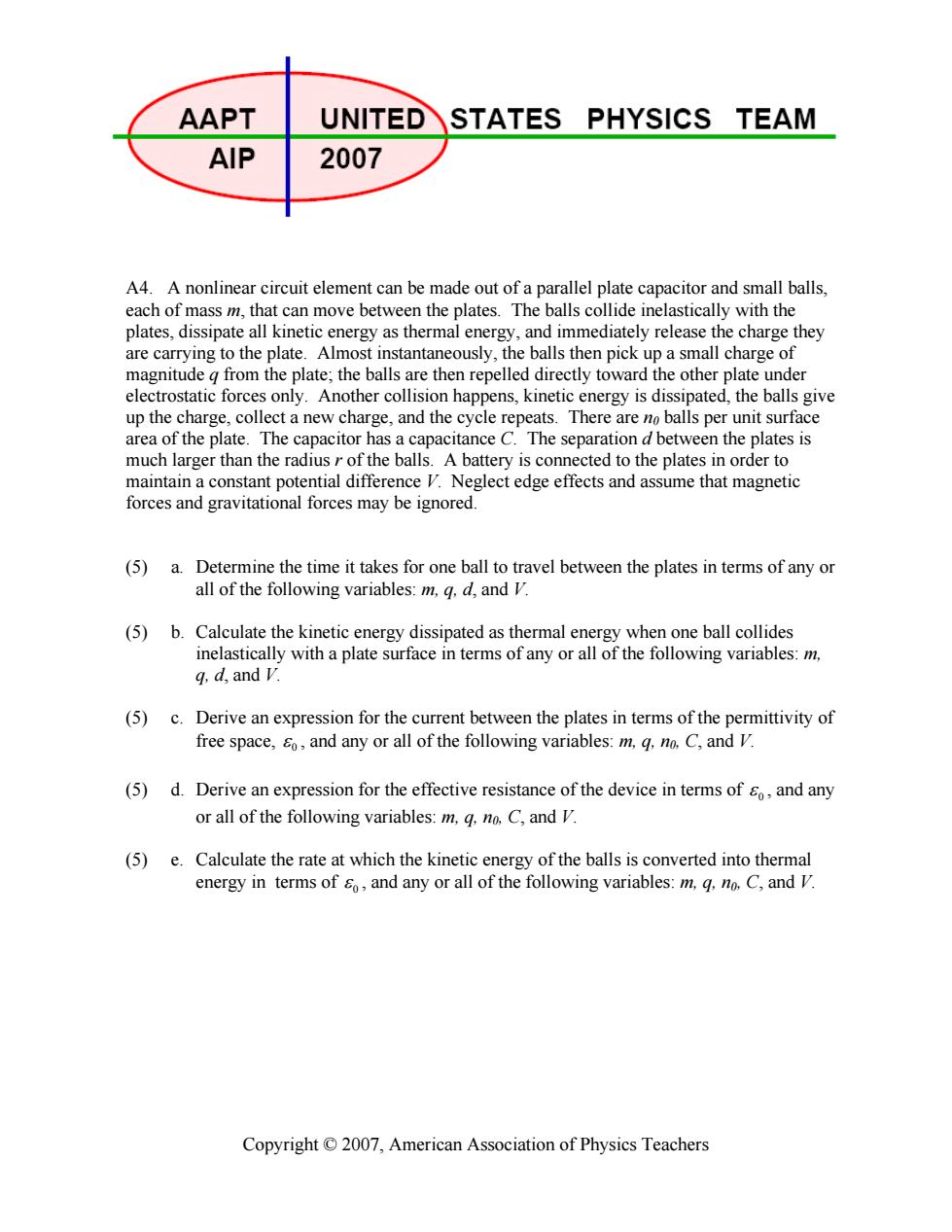正在加载图片...

AAPT UNITEDSTATES PHYSICS TEAM AIP 2007 A4.A nonlinear circuit element can be made out of a parallel plate capacitor and small balls, each of mass m,that can move between the plates.The balls collide inelastically with the plates,dissipate all kinetic energy as thermal energy,and immediately release the charge they are carrying to the plate.Almost instantaneously,the balls then pick up a small charge of magnitude g from the plate;the balls are then repelled directly toward the other plate under electrostatic forces only.Another collision happens,kinetic energy is dissipated,the balls give up the charge,collect a new charge,and the cycle repeats.There are no balls per unit surface area of the plate.The capacitor has a capacitance C.The separation d between the plates is much larger than the radius r of the balls.A battery is connected to the plates in order to maintain a constant potential difference V.Neglect edge effects and assume that magnetic forces and gravitational forces may be ignored. (5)a.Determine the time it takes for one ball to travel between the plates in terms of any or all of the following variables:m,g,d,and V. (5)b.Calculate the kinetic energy dissipated as thermal energy when one ball collides inelastically with a plate surface in terms of any or all of the following variables:m, g,d,and V. (5)c.Derive an expression for the current between the plates in terms of the permittivity of free space,5o,and any or all of the following variables:m,g,no,C,and V. (5)d.Derive an expression for the effective resistance of the device in terms of 6o,and any or all of the following variables:m,g,no.C,and V. (5)e.Calculate the rate at which the kinetic energy of the balls is converted into thermal energy in terms of so,and any or all of the following variables:m,g,no,C,and V. Copyright C 2007,American Association of Physics TeachersCopyright © 2007, American Association of Physics Teachers A4. A nonlinear circuit element can be made out of a parallel plate capacitor and small balls, each of mass m, that can move between the plates. The balls collide inelastically with the plates, dissipate all kinetic energy as thermal energy, and immediately release the charge they are carrying to the plate. Almost instantaneously, the balls then pick up a small charge of magnitude q from the plate; the balls are then repelled directly toward the other plate under electrostatic forces only. Another collision happens, kinetic energy is dissipated, the balls give up the charge, collect a new charge, and the cycle repeats. There are n0 balls per unit surface area of the plate. The capacitor has a capacitance C. The separation d between the plates is much larger than the radius r of the balls. A battery is connected to the plates in order to maintain a constant potential difference V. Neglect edge effects and assume that magnetic forces and gravitational forces may be ignored. (5) a. Determine the time it takes for one ball to travel between the plates in terms of any or all of the following variables: m, q, d, and V. (5) b. Calculate the kinetic energy dissipated as thermal energy when one ball collides inelastically with a plate surface in terms of any or all of the following variables: m, q, d, and V. (5) c. Derive an expression for the current between the plates in terms of the permittivity of free space, 0 ε , and any or all of the following variables: m, q, n0, C, and V. (5) d. Derive an expression for the effective resistance of the device in terms of 0 ε , and any or all of the following variables: m, q, n0, C, and V. (5) e. Calculate the rate at which the kinetic energy of the balls is converted into thermal energy in terms of 0 ε , and any or all of the following variables: m, q, n0, C, and V